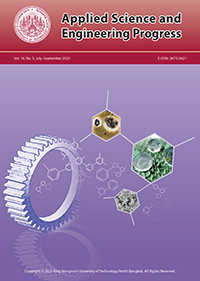Improvement of Plastic Manufacturing Processes by Six Sigma and DMAIC Methods
Main Article Content
Abstract
Improvements are required in any industry to maximize productivity by reducing faults in any method and removing overall waste produced within the manufacturing facility. This study examines the problems faced by some leading companies in the plastic manufacturing industry, such as Motorola, General Electric, and Zamil Plastic and how to solve them. In this study, the key difficulty in this plastic manufacturing industry was black dots, which can be seen in injection molding operations. When compared to other faults, the injection molding technique result shows that black dot defects are the main reason for rejects in May, making up almost 41% of all rejects. Because, Defectives Per Million Opportunities (DPMO) of products in Plastic Remote Controls (PRC) result in numerous wastes, statistical quality control (SQC) methods, such as the Pareto chart, cause-effect diagram, and control chart were utilized to examine the data. Also, this study shows that the time necessary for tool changeover was extremely long, resulting in a significant wait for manufacturing because multiple dies and molds were required for production (types of plastic fuel tanks). The novelty of this research is that it clarifies when the company uses six sigma and the DMAIC method to rapidly discover the problem in the products and find a suitable solution to save time, effort, and cost. Run charts and the layout of mold storage are used to solve the problem and ensure that the process is truly improved by reducing the time it takes to change over for tools and dies.
Article Details
References
C. Harris, R. Harris, and E. Wilson, Steps to Implementing a Lean Material Handling System. Massachusetts: Lean Directions, 2004.
T. Bendell, “A review and comparison of six sigma and the lean organisations,” The TQM Magazine, vol. 18, no. 3, pp. 255–262, 2006.
A. S. Chahal and V. Singh, “Review to six sigma: A metric and a methodology,” International Journal of Recent Engineering Research and Development, vol. 8, no. 10, pp. 58–60, 2013.
J. R. Evans and W. M. Lindsay, An Introduction to Six Sigma and Process Improvement. Massachusetts: Cengage Learning, 2014.
M. J. Harry and R. Schroeder, Six Sigma: The Breakthrough Management Strategy Revolutionizing the World's Top Corporations. Sydney, Australia: Currency, 2000.
A. Chiarini, “Improvement of OEE performance using a Lean Six Sigma approach: An Italian manufacturing case study,” International Journal of Productivity and Quality Management, vol. 16, no. 4, pp. 416–433, 2015.
M. S. Raisinghani, H. Ette, R. Pierce, G. Cannon, and P. Daripaly, “Six Sigma: Concepts, tools, and applications,” Industrial Management & Data Systems, vol. 105, no. 4, pp. 491–505, 2005.
A. K. Sahoo, M. K. Tiwari, and A. R. Mileham, “Six Sigma based approach to optimize radial forging operation variables,” Journal of Materials Processing Technology, vol. 202, no. 1–3, pp. 125–136, 2008.
C. Bott, E. Keim, S. Kim, and L. Palser, “Service quality six sigma case studies,” in ASQ World Conference on Quality and Improvement Proceedings, 2000, Art. no. 225.
A. Chiarini, “Risk management and cost reduction of cancer drugs using Lean Six Sigma tools,” Leadership in Health Services, vol. 25, no. 4, pp. 318–330, 2012.
K. Raweesawat and S. Sukparungsee, “Explicit formulas of ARL on double moving average control chart for monitoring process mean of zipinar (1) model with an excessive number of zeros,” Applied Science and Engineering Progress, vol. 15, no. 3, Art. no. 4588, 2022, doi: 10.14416/ j.asep.2021.03.002.
V. Dwivedi, M. Anas, and M. Siraj, “Six sigma; as applied in quality improvement for injection moulding process,” International Review of Applied Engineering Research, vol. 4, no. 4, pp. 317–324, 2014.
P. D. Kale, P. D. Darade, and A. R. Sahu, “A literature review on injection moulding process based on runner system and process variables,” in IOP Conference Series: Materials Science and Engineering, vol. 1017, no. 1, 2021, Art. no. 012031.
D. Desai and B. N. Prajapati, “Competitive advantage through Six Sigma at plastic injection molded parts manufacturing unit: A case study,” International Journal of Lean Six Sigma, vol. 8, no. 4, pp. 411–435, 2017.
S. Sugiarto and I. Krisnadi, “Management monitoring quantity reject, output dan cycle time produksi di mesin tapping berbasis komunikasi modbus rtu dengan labview,” Ph.D. dissertaion, Department of Electrical Engineering, Universitas Mercu Buana, Indonesia, 2018.
R. Mahendran, V. Amarnath, P. Rajkumar, L. Nirmal raj, S. Karthikeyan, and L. Rajeskumar, “Productivity improvement in a manufacturing industry by using man–machine chart analysis,” in Technology Innovation in Mechanical Engineering. Singapore: Springer, 2022, pp. 603–613.
G. Eckes, The Six Sigma Revolution: How General Electric and others Turned Process into Profits. New Jersey: John Wiley & Sons, 2002.
P. C. Gholap and T. N. Desai, “Reduction of rework the Six Sigma way: case study of an Indian small scale industry,” International Journal of Six Sigma Competitive Advantage, vol. 7, no. 1, pp. 92–116, 2012.
J. De Mast and J. Lokkerbol, “An analysis of the Six Sigma DMAIC method from the perspective of problem solving,” International Journal of Production Economics, vol. 139, no. 2, pp. 604–614, 2012.
V. Lall and A. Gupta, “A tool based framework for applying Six Sigma methodology to services and transactional data,” International Journal of Productivity and Quality Management, vol. 5, no. 4, pp. 440–451, 2010.


